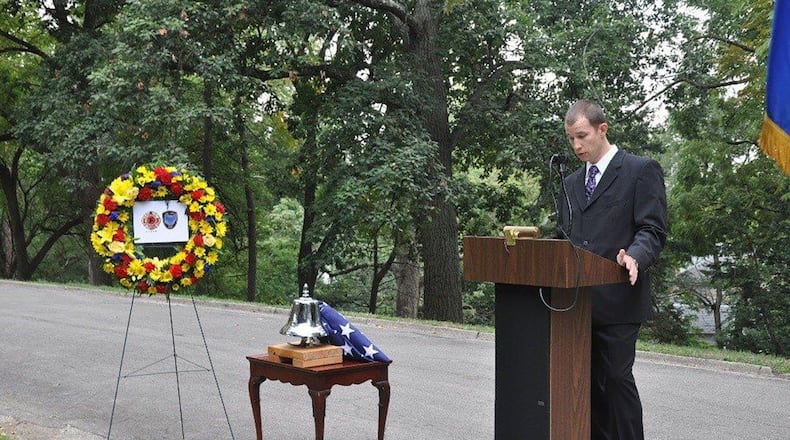On Sept. 15, 1932, firefighters from what was then Wright Field, responded to an acetylene tank explosion in a motor pool facility. During the response, one of the firefighters, Frank A. Smith, sustained severe burns to his hands, arm, head, back and chest. He later passed away at Miami Valley Hospital at the age of 43.
McKee first learned of Smith’s story in 2010, during a walkthrough of Bldg. 1 in Area A, where he got a hold of an old booklet from the base historian at the time. This discovery sparked a curiosity about the details of the life and death of Smith, which until this point had been seemingly a mystery. With the help of a friend, Larry Suttman, McKee set out to acquire whatever information that he could about this hero who had fallen in the line of duty.
After discovering from the booklet that Smith lived on Dayton-Yellow Springs Road in Greene County, McKee and Suttman headed to the Greene County Public Library in search of answers. After a lucky encounter with a librarian, who happened to also be educated in genealogy, McKee and Suttman were able to locate Smith’s death notice, as well as an old article from the Xenia newspaper, The Evening Gazette. While these resources shed some necessary light on the circumstances of Smith’s death, they knew there was more to be learned.
In early 2011, McKee and Suttman reached out to the Wright-Patterson Skywrighter, as well as local media outlets to share the story of Smith, and to seek out anyone who had further information. As a result, local resident Hilda Miller entered the picture. After seeing the stories, Miller reached out to McKee and offered her expertise to the cause.
“McKee was so dedicated to seeing that Frank was honored that it inspired me to just see what, and who, I could find,” said Miller.
“We met at a library and she provided me with an enormous amount of genealogical information that she personally investigated, complied and, most importantly, organized,” said McKee.
The extensive family history that Miller was able to provide became an integral part of the search, according to McKee.
“I think it was learning that he left a mother who would have had no children survive her that spoke to me, or perhaps she spoke to me saying it was so important that her son was being honored at last,” explained Miller. “I’ve read that as long as someone speaks our name or thinks of us after we are gone, we live on.”
With Miller’s help, he learned that Smith was buried in the Woodland Cemetery and then went out to find his gravesite.
“I discovered that there wasn’t a marker of any type for Frank. I was saddened by this finding. I was absolutely determined to change that,” Miller said.
After bringing this to the attention of Dodd’s Monuments in Xenia, they were eager to aid the cause and donated a grave marker for Smith. McKee arranged to have a rededication ceremony of his gravesite that took place in 2012 and incorporated the firefighter’s traditions of the last alarm and a presentation of the Flag.
While this rededication was a significant feat in giving Smith the recognition he deserved, there was still a missing piece of the puzzle that left McKee unsatisfied. There was no known photograph of Frank.
“We knew Frank was a firefighter, we knew how he died, and we knew where he was buried, but we had no idea of what he looked like – unacceptable,” said McKee.
Despite the fact that Smith’s death was more than 80 years ago, he was determined to track down a photograph. McKee sought out any distant relatives of Smith that might be able to locate a photo but was not successful.
It wasn’t until this past year, when McKee got in contact with Bill Stolz, an archivist at Wright State University, did he finally find what he was looking for. Stoltz was able to locate a microfilm containing a Dayton Daily News article about Smith that contained a picture.
“I was ecstatic. It was a euphoric moment to finally see the face of the man whose name graces a former fire station, a fire fighter who was buried in an unmarked grave for 80-some years, and whose death we have set out to honor,” said McKee. “We are obligated to not forget those who have sacrificed themselves protecting the lives and property of our installation. Frank A. Smith was one of our own. We, as firefighters, honor these men by teaching the upcoming generation of firefighters who these men were and what these men did.”
McKee is currently working with Deputy Fire Chief Jeffrey Kitzmiller to update plaques for former station one, Bldg. 163, and former station three, Bldg. 76, that will more accurately depict the service and death of Smith.
Additionally, a plaque in the Air Force Materiel Command Headquarters, Bldg. 262, will be replaced to honor two other firefighters, William J. Collins and Dale V. Kelchner, who both lost their lives fighting the fire that burned down Air Force Logistics Command, Bldg. 262-A, now Bldg. 266, in 1961.
Thanks to the tenacity and dedication of McKee, and the cooperation from the community, Frank A. Smith is not another name lost in history. His story and image will remain with Wright-Patterson as a continual reminder of his service and sacrifice.
About the Author
